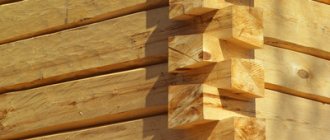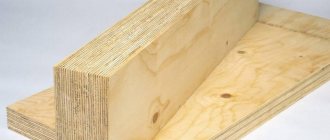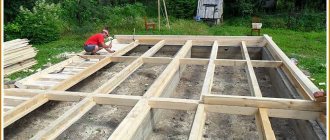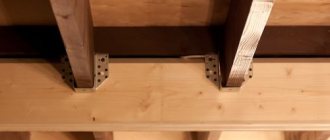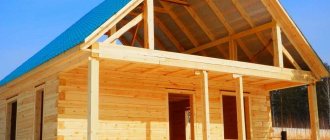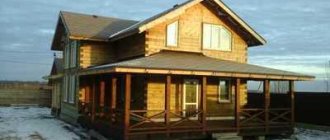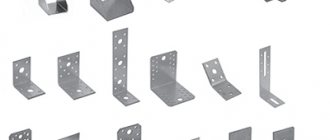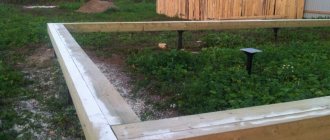The construction of buildings of any purpose from timber involves fastening the timber to the foundation. This procedure is complex and labor-intensive, and also requires the employee to have certain qualifications and experience. The reliability and durability of the entire structure depends on how well the first crown was secured. That is why installing timber on the foundation is an extremely important stage in the construction of buildings. In this article we will look at options for installing wooden beams on various types of bases.
The first stage of this process is the arrangement of a really high-quality foundation for the construction of a building, on which it is necessary to apply two layers of roofing felt sheets, and fill the surface with a cement mixture. Only now should you begin installing wooden elements on the base of the building under construction. The installation of timber should only begin when the foundation is equipped and has stood for more than a week. As already mentioned, installing timber on a foundation is a rather complicated process, and to facilitate it, the first row is used, which is called the bottom frame. To increase the strength of the structure, the harness must be made of wide material.
Before starting all work, you should stock up in advance with all the necessary tools and consumables. Here is their list:
- antiseptic composition;
- building level;
- anchor bolts;
- cement composition;
- sand;
- roofing felt;
- anchor studs.
Return to content
Attaching the timber to the foundation
The foundation is the basis of the entire structure. The choice of its type should be approached especially responsibly, having previously studied the soil on which the construction will take place. So, for example, if the soil moves, a pile type is suitable; for fluffy soils, a shallow foundation can be used. And for the construction of a country house or outbuildings, an excellent option is a foundation built from asbestos pipes or brick pillars.
But no matter what type of foundation is preferred, frame walls are built according to the same principle. For such work, it will be necessary to perform a lower trim, which serves as a kind of layer between the foundation material and the wall material. An excellent option for the bottom harness is a wooden beam. As practice shows, it is most used for these purposes. That is why many people have a question about how to properly lay timber on the foundation. Especially if the owner of the site is building a house for the first time. Timber strapping is the most affordable way to move from the base to creating a frame.
What is house strapping
The frame is the base laid on the foundation on which the house is installed. It protects the structure from the negative effects of the environment, so it must have high moisture resistance.
Framing the house is also needed to evenly distribute the weight of the building around the perimeter. For columnar and pile foundations, timber piping combines the foundation elements into a single structure called a grillage.
It is better to make the harness from a material made from coniferous wood. It has advantages compared to deciduous species:
- longer service life;
- higher strength;
- less moisture permeability;
- lower cost.
Rules for performing construction work
Attaching the timber to the foundation must comply with the regulatory requirements for building a house. With proper and strong fixation, it is possible to avoid the formation of cracks on the wall in the future, and even, in some cases, the destruction of the country house. To successfully complete the work and have a long period of use of the material, you should use certain rules and advice from professional builders, who will always tell you how to lay the material:
- Before placing the first crown, it must be treated with a special antiseptic. This substance can be purchased at a hardware store. Processing timber from timber will prevent rotting and extend the service life of the material. It is necessary to fasten the timber to the foundation after preliminary processing - this is one of the main requirements of construction;
- The first crown of the timber should be laid on waterproofing material. A layer of roofing felt will become a reliable barrier to moisture penetration. Attaching a log frame to a “bare” foundation is strictly prohibited. Such a transition from timber will make the house much more resistant to precipitation;
- the timber must be firmly attached to the base, since the foundation is constantly subject to hermetically sealed changes. For example, the adverse effects of groundwater, soil wetting by precipitation, and its drying out lead to changes in the foundation itself. And nothing can be done about it. This is the law of nature. But by securing the timber especially firmly, you can avoid wall deformation and the formation of cracks.
Laying timber is a simple type of work that can be performed by every owner of a summer cottage.
Installation of joists on the floor
When performing work inside a residential building or apartment, the problem of installing joists on a finished concrete floor often arises. This type of work is used if it is necessary to insulate the lower surface of rooms, level it, or lay one or another type of floor covering. In this case, two installation methods can be used.
The first method involves rigidly fixing the bars to the base, which can be done in the same way as fixing the logs to the foundation in the form of a concrete slab. To install the logs in this case, you can use dowel nails or plastic dowels with self-tapping screws of the appropriate length.
Using preliminary markings, or using pre-perforated logs as templates, we drill holes in the floor. Their diameter should allow the fasteners to be tightly installed. Next, we fasten the logs using self-tapping screws or dowel-nails, controlling the horizontalness of the surface of the beams and the overall flatness.
Subsequently, after attaching the logs to the concrete floor with your own hands, you can insulate the base by placing the selected type of insulation in the gap between the bars. Before installation, do not forget to thoroughly treat the wooden parts with antifungal stains and fire retardants, which reduce their flammability.
The second option is more preferable from the point of view of ease of leveling the surface of the joists in one plane. It involves installing floor beams on adjustable screw supports. Raising or lowering certain parts of the base of the future floor is carried out by rotating the supports clockwise or counterclockwise. Thanks to this simple method, floor joists can be given ideal flatness.
Thus, as part of this review, we examined the main methods of installing floor joists in houses on foundations of various types, as well as in rooms on concrete foundations. The technology of many of the methods described is simple and can be done with your own hands.
When making a foundation, is it possible to fix 150x150x100 mortgages in it and then remove them? Then install 100x150 logs into these niches on the upper level with a plinth, so as not to embed the logs into the lower crown. In the future, when laying the floor timber, it will be adjacent to the backing board.
Andrey, Khotkovo.
Hello, Andrey from Khotkovo!
Yes, this is practiced.
The only conditions are that there should be completely reliable waterproofing of the joists from the stone base. This is done by antiseptic treatment of the logs and wrapping them in two layers of waterproofing such as roofing felt on all sides, including the ends.
And so that there is a strong and rigid fixation of the floor timber to the backing board. So that later there is no squeaking when walking on the floors.
Construction in Moscow and Moscow region
Wide range of construction services. Foundation, walls, ceilings, roofing, turnkey!
Other questions on the topic of gender:
Construction in Moscow and Moscow region
Wide range of construction services. Foundation, walls, ceilings, roofing, turnkey!
Construction in Moscow and Moscow region
Wide range of construction services. Foundation, walls, ceilings, roofing, turnkey!
Construction in Moscow and Moscow region
Wide range of construction services. Foundation, walls, ceilings, roofing, turnkey!
Semenych (author of materials)
Our site is regularly updated with interesting and unique materials and articles on the topics of lumber, building materials and works, the author's opinion and knowledge of a real coven with more than 15 years of experience are provided. There is a section - funny stories of shabashniks. If you would like to receive information about this, subscribe to our website's newsletter. We guarantee that your address will not be shared with third parties.
Fixing the first row to the strip foundation
You can firmly fix the wooden beam to the strip base using anchor bolts. The advantage of this fastening method is the possibility of fastening directly at the construction site. This installation of timber is one of the simplest, but at the same time, reliable works. To perform such fixation, it is necessary to lay the timber on a previously prepared foundation covered with waterproofing. At the fastening points, you should make holes in the wood using a drill and a special bit, remove the wood and use a hammer drill to make a hole in the foundation. The last step is to install the anchor bolt into the finished hole and tighten it with a spanner.
Strong fastening of the beam to the foundation using anchor bolts provides not only proven fixation, but also allows, if necessary, to lift the entire structure above the foundation using jacks. The laying of the first crown should be done especially evenly. Therefore, it is recommended to level the foundation before attaching the wooden beam. Also, when laying the material, it is recommended to constantly monitor the evenness of the surface. The use of anchor bolts allows you to quickly, simply and very firmly fix a wooden beam on the base of a country house or outbuilding. You can attach the first row of wooden beams yourself, even without experience or special equipment. Fixing with anchor bolts will not take too much time, and the fixed material will be fixed especially securely.
Scheme selection
Scheme of rigid beam fastening
You have two options to choose how to attach the prepared timber to any type of foundation:
- Hard. The fixed connection between the upper plane of the support and the lower part of the house is achieved by metal coupling bolts or anchor bolts (studs), clamps.
- Overlay. The adhesion is determined by the weight of the entire house, distributed over the contact area with the structural components of the foundation of the selected type.
A rigid scheme during soil movements prevents relative displacement of the elements of the crown and base, which is unfavorable for the entire house. In the pile type, the logs serve as a variation of the grillage, tying all the columns.
In construction sites where there is no reason for such concerns, the second option prevails. The first belt is laid on slats no more than 15 mm thick, treated with bitumen on 2 wide sides. The corners of the perimeter of the house need additional reinforcement with brackets and steel plates.
In any option, a layer of waterproofing material (roofing felt) is made between the surface of the log and the cement/metal support.
Fixing wooden beams to screw piles
Attaching the timber to the piles is also not difficult. To attach a wooden beam to a screw foundation with your own hands, you need to:
- connect two wooden beams together. You can simply fasten them together using a special metal plate: one side of the product is attached to one beam, the other side to another beam;
- fix the wooden frame made of timber on the prepared site with your own screw. This can be done using ordinary self-tapping screws;
- check the fixation for strength. The installation of the wooden material is ready, and the construction itself is ready for a new stage of construction. Many people are interested in whether it is necessary to check the strength. The answer is clear - it is absolutely necessary, since in the future this part will be responsible for the strength of the entire structure.
Fasteners
You can fasten the timber to the concrete with dowels or regular pins. If the concrete is strong and dense, concrete pins or dowels will also work. If the concrete is not very reliable, it is better to use dowels. Pins are a good thing, but they have a hex head, and to tighten them you need to have a special tool with the right size heads.
If you attach the logs with anchors, you need to drill a hole deeper - right up to the middle of the thickness of the beam, because nothing should stick out above the beam
General rule for choosing fasteners by size:
- The length of the fasteners is selected according to this principle: no less than the length that “sits” in the beam should go into the base, or better yet, twice as much. If you have 10 cm in the timber, then at least 10, and preferably 15 or 20 cm, should go into the concrete. This, by the way, is another reason why it is better not to attach it to the floor slab of a high-rise building. The end of the selected fastener can look out from the ceiling of the neighbors below.
- The hairpin or dowel-nail must be “with a neck”. That is, the thread should start not from the cap itself, but below. Due to the presence of a section without threads, the beam is attracted to the base.
- The diameter is chosen according to the principle - as long as it is not small. In general, after selecting the length, there are not many options left.
Regardless of what type of fastener you choose, you shouldn’t skimp on it. The thread must be cut clearly, the metal must be strong and not overheated.
Anchor nails can be used to attach wooden beams or joists
Beam fastening methods
In addition to anchor bolts, wooden beams can be secured with your own hands using dowels. This installation is laid at the moment of pouring the foundation:
- Even when pouring the foundation, it is worth laying a vertical rod in a horizontal position, to which the wooden beam will be attached. The pre-prepared pin is cut to 2/3 of the thickness of the timber. The metal element should not pass through the beam;
- according to the markings and location of the metal pins, it is necessary to drill a hole in the wooden frame;
- put the wooden beam on the metal pins. The installed beam must be fixed very tightly, so it is recommended to first determine the diameter of the hole.
The laid material will not allow the product to move horizontally. With this fixation, you can perform the work firmly and reliably. Strapping material is an integral part of construction. And such work should be performed in the same way as others, observing the requirements of the construction industry.
How to fix a joist to a concrete wall
The joists do not always rest on the floor. They can rest on a protrusion in the foundation, or they can rest on special supports for timber, mounted on the walls. For these purposes there are U-shaped metal supports. They are attached to concrete walls or to foundation walls using the same anchors or dowels. First, mark a level on the walls along which the mounting plates are aligned. Next, they are attached to the walls, and then timber is laid in them.
The beam support is open - made of galvanized steel 2 mm thick
The procedure for installing fasteners is the same: marking and drilling holes, and then attach the plates. If the beam support is attached to the foundation walls, then do not forget about waterproofing. Sound insulation is also important. Gaskets are placed between the wall and the plate. In the simplest case, these are pieces of roofing felt folded in half. Next, a beam is inserted into the plates. You don’t have to attach it to the plates, since there is simply nowhere for it to go.
How to attach timber to the foundation. Connection methods and their features
When building a house from timber, it is necessary to resolve the issue of attaching the first crown to the foundation. The further operation of the building mainly depends on this. For this operation, several technology options have been invented, which we will discuss below.
You will learn how to properly connect timber to a slab, strip, or pile foundation. We will tell you how this is done, and what materials and tools for them should be prepared in advance.
Attaching a beam to a columnar foundation using a reinforcing pin
General installation information
So, if you are interested in the question of how to attach logs to brick posts, then you are seriously thinking about creating a reliable and durable floor. However, with this installation method, you will need to resort to constructing a foundation, and most importantly, it must be done in such a way that it can easily support each installed brick support. You can pour the foundation for installation separately or make it in the form of a narrow strip. The height of the support can be determined using the height at which the timber will be placed.
Columns
To find out the consumption of materials for installing columns under the logs, you need to perform a calculation and then draw up a plan that will indicate the layout of the subfloor, what materials will be required and their quantity. This will need to include the following materials: timber, high-quality cement and bricks.
Laying
To ensure that the lags are laid in a column efficiently, it is recommended to follow the following rule: where the load in the room is insignificant, a larger distance can be maintained between the lags. If thin material is used for flooring, then it is recommended to place the logs close to each other.
This suggests the following conclusion: the smaller the distance between the lags, the higher the strength characteristics of the structure.
However, such a solution leads to high consumption of materials, and therefore an increase in monetary costs. But the end result will be of high quality, and the laid floor will last a long time.
Fixation depending on the type of base
From other publications on our portal, you already know that in construction there are several types of foundations, each of which differs not only in design features, but also in the place where they are best installed.
This depends on various factors, among which the predominant structure of the soil on the site and the price of all work, since it is no secret that the earthen stage of building a house can exceed half the cost of the project.
How to attach a beam to a foundation using a dowel anchor
Slab and strip
Before working on a slab foundation, you need to prepare:
- drill holes in the slab at a distance of 500 mm between their centers;
- insert bolts with locknuts into them;
- make holes of the same diameter and at the same distance in the beam while the foundation hardens.
Advice: it is best to carry out preparatory actions simultaneously with assembling the base or pouring it.
- Check the horizontalness of the top plane of the foundation and make sure that there are no depressions (fill them) or irregularities (scrape them);
- Cover the base with a waterproofing layer, for which ordinary roofing felt is excellent;
- Place a wooden crown on the studs and secure it with locknuts.
How to secure a beam to the foundation using a pin
The timber is attached to the strip base in the same way. The only difference is that there is no need to install bolts in the upper part of the foundation; a dowel is used. In this case, the frame of the house should be prepared and assembled in advance.
Pile
For rigid fixation, the process instructions are as follows:
- insert U-shaped heads into the holes for the studs on the side of the piles;
- cut blanks from timber;
- install a beam into the hole in the head and secure it with a pin;
- mount the heads into the pile, for which you first place a beam on them, placing corner brackets under it, and then weld them to the piles;
- remove the log and weld the remaining heads onto the brackets;
Tip: place roofing felt between the metal and wood to avoid contact between them.
- install the foundation beams into the brackets and secure them with screws.
How to fasten timber to the foundation with anchor bolts
This method makes it possible to assemble the building much faster, since the lower tier of the building is used in the process.
Tip: If fasteners are not used, the timber should be mounted to the T-shaped head.
Upon completion of the work associated with installing and fixing the logs to the foundation, you can begin to build walls. It should be remembered that the crown beam must be completely dried so that there is no deformation of the house frame in the future.
Advice: before installing it on the foundation, the log must be treated with an antiseptic.
Beams as they are
Floor beams are currently represented by a fairly large list of different products. The simplest option is a timber beam of regular rectangular cross-section, determined based on specific construction conditions.
A more complex type of floor joist, which requires a lengthy manufacturing process, is I-beams with a cross-section in the form of the letter H, placed on one of the sides. They are made from high-quality dried and planed wooden blocks and strips of OSB or high-quality moisture-resistant premium plywood.
The operating principle of I-beams in the form of floor joists involves the distribution of the main forces in the form of bending loads along flat stiffeners. Thanks to this, with a small mass, they are able to withstand very heavy loads. In addition, manufacturing technology and strength make it possible to produce I-beams for openings with a width significantly exceeding the standard 6 meters.
Laying logs on the foundation is carried out according to certain rules, which will be discussed later. Immediately before installing lumber, it is necessary to properly prepare it for further use. You should choose high-quality bars made of oak, aspen or coniferous wood. The main requirements for them are as follows:
Tying the base with timber
This method can be used for foundations of any type, especially for pile foundations. Thanks to this, it is possible to evenly distribute the load from the frame of the house along the perimeter of the latter, thereby increasing its service life.
The tying process should begin after all cavities have been filled with mortar, but the heads have not yet been installed. Thus, it will be possible to avoid changes in the level of installation of piles due to processes occurring inside the soil.
In the photo - foundation piping
How to make a strapping
The process is as follows:
- Prepare a building level and check the accuracy and correct installation of the piles. All detected inaccuracies must be eliminated as quickly as possible;
- Place threaded rods in the corners filled with mortar;
- Also install aluminum corners in the corners;
- Join the logs together by sawing at the top and bottom, and then connect them at right angles. Be sure to wrap the joints with jute.
Once the bottom binding is completed, move on to the top. Usually the last stage goes faster, and doing it yourself is not difficult.
Laying piping on a pile (screw) foundation
First you need to check the horizontalness of the foundation. If some piles are above the level, they are buried or the excess is cut off. If the difference is small, it is easier to make a cutout in the timber. Gaskets are placed on low supports during installation. By stretching a string between the piles, the evenness of their installation and the squareness of the foundation are checked.
Then the heads are prepared. If the piles protrude more than 0.5 m above the ground, metal plates with holes for attaching the timber are welded to them. When the supports are located low, caps are used made from sections of pipe with a diameter larger than that of the piles. Plates reinforced with scarves are welded to them.
On straight sections it is more convenient to use U-shaped heads made from channel bars. The timber is laid inside and secured with self-tapping screws through holes in the side walls. However, on the corner supports you will have to install plate heads or weld plates bent at right angles. They need to be placed outside the harness.
Depending on the method of connecting the beams, their ends are prepared. After laying the waterproofing, tying the pile foundation with timber begins from the corner:
- lay two adjacent beams, then the rest;
- after connecting all the elements, the horizontality and squareness of the strapping is checked again, and adjustments are made if necessary;
- fix the bars on the heads, first in the corners.
It is advisable to place jute tape at the joints. This will eliminate squeaks during foundation shrinkage and thermal expansion of the material. When fastening with self-tapping screws, they must be positioned along the longitudinal axis of the beam. Otherwise, the load distribution will be uneven, which may cause the harness to break. If it is necessary to splice two beams along the length, the junction must be on a support.
Tools and materials
To install the beam vertically on the foundation, you need to prepare the following tools and materials:
- building level;
- cement M500;
- sand cleared of impurities;
- antiseptic for treating wood against mold and mildew;
- roll of roofing felt for waterproofing;
- anchor studs;
- wooden beam.
Important! The timber is laid on a concrete foundation if it has stood for 7 days or more.
Quality of timber for strapping
Experts recommend choosing products made from wood harvested in winter. They must be free of cracks, chips and places damaged by pests.
Strapping beams with a humidity higher than 18% cannot be used without preliminary drying, as they become deformed after drying. Drying is done indoors, as wood cracks in the sun. Larch is considered the best material for the first crown laid on the foundation, since it does not rot and is not afraid of moisture.
The prepared material must be treated with a fire retardant to increase fire resistance. Especially if it is made of pine, which contains flammable resins. Impregnation with an antiseptic will protect against fungal infection and rotting.
Requirements for wood
When choosing timber for building a wooden house, you should proceed from building codes and regulations, and specifically from GOST 2695-83. The first crown of timber must be laid on a foundation made of larch or oak. These materials have good strength and durability. To extend their service life, they must be treated with an antiseptic.
When choosing wood for building a frame house, the following points are taken into account:
- The cross-section of the timber is 20 × 20 centimeters; the lumber should not have any bending, falling knots or other defects.
- The maximum wood moisture content is 20%. It is best to take logs from winter felling, which took place from December to March. The tree should be aged under a canopy or in another room with natural ventilation. Decks are placed in piles in accordance with the rules of storage.
- Absence of defects allowed by state standards. These include damage to wood from bark beetles, mold or mildew.
- Absence of defects that may remain after processing the material on a sawmill.
Schemes and technologies for fastening to the foundation
There are two ways to secure a wooden beam to the foundation. Let's take a closer look at them:
- Hard method - fastening of wooden products occurs using special clamps. The result of the work will be a stationary and reliable supporting structure.
- Overlay - the beams are laid along special cutouts; there are no fastening elements between the lumber and the base. The reliability of the structure is achieved due to the weight of the building, which presses on the lower crown.
Of the two indicated methods, the first is considered more reliable, the second method is easier to implement.
Columnar
Columnar-type structures are used for the construction of residential buildings on unstable soils. The service life of such a foundation is within 30–40 years. Here everything depends on the material used to make the columns (brickwork, concrete, asbestos-cement or metal pipes).
When building a wooden house, a project is drawn up, which determines the number and area of supports, as well as the distance between them. It is necessary to pay attention to the fastening of the timber to the pile foundation. Here you need to take into account the nuances of securing the first row of bars.
Before carrying out the main work, align all the columns in the same horizontal plane. For this, a water building level or level is used. The uniform shrinkage of the house and the durability of the building structure depend on the correctness of such actions.
Important! According to SNiPs, the wooden beam for laying the bottom row should be 5 centimeters larger than other products.
For piping, parts with a cross-section of 20 × 20 centimeters are taken; for the installation of load-bearing walls, square beams with a cross-section of 15 × 15 centimeters are used. The need to select a larger cross-section of wooden products for strapping is due to the fact that they bear the entire weight of the building and short-term loads (snow on the roof, etc.)
You should familiarize yourself with the nuances of attaching the beams to the columnar base. When building a bathhouse or wooden house, the lower crown is fixed through special embedded parts, pins with a diameter of 1.4 centimeters. These bolts are secured into the concrete posts as they are poured. After gaining sufficient strength, the first row of beams is fixed on the supports by clamping the nuts.
A similar situation occurs with brick columns. At the time of installation of the masonry, threaded rods of the same diameter are fixed in its structure. In this case, the upper part of the reinforcement must intercept the thickness of the wooden beam with a margin so that the lower crown can be intercepted. After fixing, the unnecessary part of the pin is cut off with a grinder. In cases where the posts are ready and the studs were not installed during the installation process, they can be replaced with anchor bolts.
Remember! Moisture condenses where metal touches wood, which can lead to corrosion of the steel and the appearance of mold or mildew on wooden structures. Problem areas must be treated with paint or antiseptic.
Tape or slab
When installing timber on a strip or slab base, preliminary preparation of the surface is carried out. Holes are drilled along the perimeter of the foundation at a distance of 50 centimeters from each other and anchor bolts with nuts are installed. The same holes are made in a wooden beam.
Before fixing the beam, it is necessary to check the horizontal plane of the base and lay a layer of roofing material that will be used as waterproofing. We place wooden blanks on the protruding bolts and secure them with nuts.
Let's look at the process of installing the bottom trim in more detail if the work is carried out along with pouring concrete:
- Bolts are installed into the newly poured concrete at a distance of 50 centimeters and left to harden. Fasteners must have curved ends.
- Drill holes in the timber at the required distance for the studs.
- Check the levelness of the base using a building level and level out any unevenness.
- Roofing felt is laid.
- In the corner parts, the beams are additionally fastened using metal squares and self-tapping screws.
- Place the beam on the bolts, install washers and secure its position by clamping the nuts.
Attaching the timber to a strip-type foundation occurs in the same way as a base made of blocks or slabs. In the latter case, it is necessary to assemble the crown frame in advance. Fixation is carried out using dowels.
Pile
Attaching wood material to piles is done as follows:
- U-shaped embedded parts are installed in the holes on the side of the supports;
- blanks are cut from timber;
- wooden products are installed in the head and fixed with fasteners;
- The bars are installed along one line, staples are stuck in and welded to metal piles.
Important! To prevent contact between wood and metal, pieces of roofing material are placed under the piles.
Screw
The construction of a residential wooden structure on a screw foundation occurs quite quickly. The timber is attached to this base quite simply. At the initial stage of work, it is necessary to measure the length and width of the building, after which we check the horizontalness of the surface using a level. We soak the timber with an antiseptic solution and leave it to dry.
Installation work is carried out in the following order:
- drill holes in wooden products for fasteners (their depth should be 2 millimeters greater than the fasteners);
- lay timber around the perimeter of the building;
- secure it to the screw foundation with bolts.
The harness is considered the easiest to install. In addition, it is reliable and durable.
Location
If the thickness of the board is at least 50 mm, in this case the logs are laid at a distance of one meter from each other. However, in private housing construction, 40 mm boards are more often used; in this case, the logs are placed in increments of 70 cm. Many people are interested in the question of how to make the structure reliable and the loads accurately distributed? Here it is important to maintain the exact distance between the lags. The first board is laid no further than 25-35 cm from the wall.
Distance
The main rule that must be followed if you want to perform correct installation is location. The logs are laid perpendicular to the floor boards. If boards in two layers are used to create a structure, then the top one is laid “cross” to the bottom one.
Installation of logs in different rooms is carried out differently. If the installation is carried out in the living room, then the floor boards are installed in the direction of sunlight. In this case, the logs themselves are mounted in a transverse position. But for rooms where there is a lot of traffic, floor boards are laid in the direction of movement.
Distance table
Double harness
This type of strapping involves the use of two rows of wooden beams of different sections. The structure can be fixed to a screw foundation in two ways:
Threaded connection
They place roofing felt under the supports, place a beam with a cross-section of 20 × 20 centimeters on the screws and tap it with a hammer. In the corner parts, wooden products are fastened using a metal corner and self-tapping screws. The second row of strapping is secured using through metal pins.
Clamps
When fixed to clamps, the first row of timber with a cross-section of 10 × 15 centimeters is laid edge down. The joints of the elements are made in a checkerboard pattern; they should not coincide. The harness is attached to the piles using U-shaped bar clamps. They are mounted on the previous element.
Installing joists on a concrete base: to fasten or not
The logs are placed on a concrete base to lay plywood (other sheet material) or boards on top. Moreover, sometimes the timber must be rigidly attached to the concrete, and sometimes it is better to do without a rigid connection. It depends on what is under the concrete foundation.
If there are neighbors below, it is better to do without fasteners. Because the presence of a rigid connection will violate sound insulation. It’s not very good in multi-storey buildings anyway. Therefore, in high-rise buildings, vibration-damping rubber pads are placed under the joists. With their help, the logs are leveled and set to the required level. They are also laid between the ends of the beams and the walls. This way, your neighbors won't complain about you stomping too loudly.
Whether or not to attach the logs to the concrete floor of a high-rise building is up to everyone to decide for themselves.
If the joists are not secured, will the floor be reliable? Will. In the rooms, clamped with rubber gaskets, it is secured sufficiently. Any type of flooring—boards, plywood, OSB, or any other sheet material—will hold the entire structure together. Finally, he is loaded with furniture. This design has served for decades without any problems. There is just one point: the timber must be dry and chamber drying is better. That is, it will not lead during operation. When using damp wood, it is still better to secure it, since if the logs “lead”, the loose beam may rise.
To ensure that the timber does not move, you can make it composite. That is, take two or three boards, which in total give the required cross-section and connect them into a beam. They are connected with nails or self-tapping screws, which are driven in on both sides in a checkerboard pattern. When laying out the boards, you need to make sure that the annual rings of the wood are directed towards each other. A timber spliced in this way will definitely not move. This is also a real chance to save money, since three 50*25 mm boards will cost less than 50*75 mm timber. But it’s still better to buy a dry board.
In what cases are logs attached to a concrete base? Usually in private houses in which the floor is screeded. Most often, this is a rough screed on the ground, which is designed to cut off nearby groundwater. At a normal groundwater level, a screed on the ground as a basis for laying lags is simply unnecessary. In this case, it is much easier to simply lay down columns of stone or brick and support the logs on them.
Residents of the first floor can attach the logs to the concrete floor slab. Soundproofing in the basement is not necessary; no one will complain there. But this is absolutely not necessary. It is worth paying more attention to waterproofing and insulation.
Attaching the frame of a wooden house to the foundation
Most owners of country houses or cottages want to build additional outbuildings or a real bathhouse on the site. Most often, such buildings are erected from timber - it is convenient and practical. But the foundations for them can be very different. Therefore, the question of how to lay and strengthen the strapping beam on the foundation is very widely discussed in construction circles. Our article provides detailed recommendations on how to attach timber to the foundation with your own hands.
The frame is a necessary element of a log house; it is the lower crown of the house, which serves to strengthen the foundation and into which it is not recommended to cut floor joists.
Fig 1. Strapping on a columnar foundation
Purpose and types of grillage
The strapping is both an action and a device, which means that this element connects the pile heads into a single structure. It serves to uniformly distribute the load from the building onto each pile. The types of grillages depend on the material they are made of:
- The metal one is made from a channel, which is attached to the pile heads by welding. For this case, and in other cases too, the top of each pile ends with a horizontal steel plate with holes for bolts or with welded studs. All metal structures must be coated with anti-corrosion compounds.
- Reinforced concrete framing can be made from prefabricated elements in the form of lintels or crossbars, which are connected to each other and to pillars. The second option is a monolithic reinforced concrete structure, which is made according to the principle of a strip foundation. It is very convenient and practical to make such a grillage in permanent formwork, which simultaneously serves as an enclosing element and thermal insulation.
- Wooden lining of the foundation on screw piles with timber or logs is usually done for buildings made of wood. Rounded logs are used for arranging the foundations of log houses. Natural or laminated timber - for frame buildings. For the grillage, products with a cross-section of 150×150 mm are used, and steel studs or bolts are used as fastening elements. Fastening can be carried out by landing on the threads coming out of the piles. Or bolts through holes in the embedded parts of the pillar heads. Sometimes tying the foundation with timber is done using wire rod clamps. But, in any case, the head of the pile is covered with roofing felt or pieces of flexible tiles to create a waterproofing layer.
How to tie a wooden house to the foundation before
When building houses in ancient times, when wood was the main building material, our ancestors used wood to construct the foundation. Today this option seems very strange, but many centuries ago this technology was considered correct. How was this accomplished? A clay-sand cushion was laid directly on the ground, and the lower crown of the frame was installed on it. As a rule, the first crown was made of oak. It was well lubricated with tar or resin. We can say that this crown acted as the frame and foundation of the entire structure. The sand provided protection from rain, and the clay protected the crown from the effects of groundwater. Since then, a lot has changed and the technology for laying and fastening timber to the foundation has become different.
When constructing any buildings made of timber, foundations of pile or strip type are very often installed. We will look at attaching the log frame to both of these options.
Floor insulation
Warming is also a very important stage. Below, on one and the other side of the wooden logs, support bars 50 × 50 or 30 × 50 mm are nailed.
Next, a roll is laid on the block, which is an unedged low-grade board; its thickness should be 25 mm. Before laying, such boards are treated with a special antiseptic composition to protect the floor from rodents and insects. Self-tapping screws are used to attach the knurling to the bars.
Insulation
Next, a waterproofing membrane with a throughput capacity of no more than 800 g/m is laid on the created bead. It will protect the heat insulator from exposure to moisture. Afterwards, a heat insulator is mounted on the laid waterproofing layer. Considering that today there is a large assortment of insulating materials on the market, there will be no problems with the choice, but you should understand that not every one of them can be used to insulate a wooden floor.
Here it is recommended to choose mineral wool with a density of 35 to 55 kg/m². When laying, a gap of 2-4 cm is left between the boards and the heat insulator for ventilation.
Fastening timber frame to strip foundation
Walls made of wood (be it rounded logs, beams, etc.) are very difficult to attach to the foundation. To accomplish this task, a beam of greater thickness is taken as the first crown that is laid on the foundation.
In order to attach the timber to the foundation, anchors are used.
Fig. 2. Attaching the strapping with anchors to a strip foundation with a grillage
Sequence of work
- You will need fasteners, take extra.
- Carefully check that the surface of the foundation is level. To do this, use a building level. If unevenness of more than 10 mm suddenly appears, be sure to eliminate it with a solution. Irregularities of less than 10 mm can be corrected with planks that are placed under the beams.
- Place the crown of timber on roofing felt for waterproofing purposes.
- The lower crown of the harness is bars that interlock with each other in one of two ways - “into the paw” or “into the bowl”.
Fig 3. Connecting corners “into the paw”
Fig. 4. Connecting the corners of a timber house “into a bowl”
- Holes are drilled in the beams that are laid on the lower crown. The diameter of these holes is slightly wider than the diameter of the anchor studs that were previously installed and concreted at the top of the foundation.
- Then the beams with drilled holes are laid on the anchors. Next, install wide washers under them, which are secured with nuts. When the corners of the lower rims are connected to each other with nails or dowels, anchors do not need to be installed in such places.
- Using a building level, determine the exact location of the corners and diagonals of the upper level of the trim. If any unevenness occurs, smooth it out with a plane.
- Once the installation of the bottom trim is completed, you can install the vertical guides for constructing the frame.
By the way, the described method of carrying out the lower trim is relevant both for strip foundations and for any other type of foundation, with minor amendments and technical features.
Bottom frame of the foundation with timber
For the strapping I used a 150mm x 150mm beam; at first I wanted 200x200, but there was no such thing available on the market. Although even 150mm x 150mm is a sufficient cross-section for my project. You can select the desired cross-section of timber using the construction calculator here. We indicate the maximum distance between adjacent piles (mine is 1.3 meters), indicate the maximum concentrated load (999 kg) and check the required cross-section. With my values, the deflection margin is 5 times, in my opinion, enough. Before laying the piping, the tops of the piles were coated with bitumen mastic, on which two layers of roofing material were laid - waterproofing the foundation.
“Waterproofing is needed to protect the framing beam from moisture that the concrete foundation absorbs from the soil (concrete has this property).”
For greater reliability, I placed scraps of bitumen shingles on the roofing felt, although this is not at all necessary.
I pre-treated the strapping beam with the Senezh Bio antiseptic for severe conditions. The strapping beam is laid out along the entire perimeter of the foundation. All connections are made half-timber and secured with 120 mm nails. At the corners, the connections are reinforced with metal corners nailed with 60 mm nails. The length of the walls is 7.5 m and 9 m, so the frame under each future wall consisted of two beams connected in half a tree. To strengthen this connection, metal plates were used, nailed with 60 mm nails. To attach it to the foundation, the harness was put on pins embedded in the corner piles (diameter 10 mm) and secured on top with a nut.
Post with waterproofing made of flexible tiles Fastening timber to a pin Post covered with bitumen mastic Corner post Joint in the corner Half-wood joint Liners Holes for fastenings are treated with antiseptic more intensively
The main difficulties when installing the strapping:
- the piles under each future wall were not always located in one straight line (errors during marking or pouring);
- not all the piles were at the same level from the ground (either they settled after pouring, or this was also a marking error), so it was necessary to make pads between the pile and the frame so that the frame stood level. I controlled the level using a bubble level;
- If, when drilling a hole in a beam for a fastening pin, you hold the drill unevenly, problems with putting the timber on the pin cannot be avoided: you had to redo the hole, drill it out or pick it apart.
A 150mm x 50mm board is laid flat on top of the harness, covering the joints of the timber. This is the lower part of the frame of the first floor wall; in fact, this is also the lower frame; the frame posts will be installed on it. The board was antiseptic and attached to the beam with 120 mm nails with a pitch of approximately 500 mm.
Then the floor joists were laid on the already fully assembled frame. A 200mm x 50mm board was used for the logs; the cross-section was also selected using a construction calculator. The logs were laid in 600mm increments (between the centers of the boards) and fixed with nails to the strapping (this is how we simply nailed them on). All the building materials for the frame were laid on the resulting base.
Fastening timber frame to a pile-screw foundation
Why is 1-2 rows of strapping needed for a pile foundation? Because piles with caps are point supports. Such supports cannot guarantee that the load will be distributed evenly between all platforms. Surely some piles will have more weight, they may sag, which will adversely affect the entire building.
If you tie the foundation as required by technology, then uniform distribution of loads over the entire area of the foundation will increase the strength, reliability and durability of the foundation and the house itself. We emphasize that the piping should be done literally immediately, as soon as the cavities are filled with mortar and the heads are installed. The soil is different in different places, and internal mechanical processes can disrupt the entire technology. Who then wants to align piles that have moved? In addition, this is a difficult and labor-intensive task. It is better to install the piping correctly right away, meeting all technological requirements, than to repair it later - it’s cheaper and easier.
Fig. 5. According to this scheme, the piles are tied with timber
Strapping process
- Check that the piles are installed correctly and level. If minor deviations are detected after the heads have been installed, it is imperative to eliminate these errors: simply cut out pieces of beams in places where they are superfluous.
- As a rule, holes are made in the pile heads so that the frame can be screwed to them from below.
- The corners of the strapping can be fastened with aluminum corners.
Tying piles for a house made of timber will not be a problem for you if you do not do it alone.
It happens that the customer installed a pile foundation from one company, and another company will build the house for them. Some builders of wooden houses do not consider it necessary to attach the frame to the pile foundation, arguing that the house will not move from the foundation under its own weight. This is true, but the strapping is also attached to the pile foundation in order to eliminate the mobility of the pile foundation and to evenly distribute the weight of the house over the entire foundation. After all, if one pile sags, then the load on the other piles will increase.
Fastening boards
Any wood is subject to deformation under the influence of moisture and temperature changes, so the edge board is laid so that there is a gap of 1-2 cm between it and the wall, this will preserve the integrity of the wooden flooring, even with strong changes in temperature and humidity.
After laying the floor boards is completed, the gap is closed with a plinth. Nails can be used to secure the boards, but they can rust and lift off the surface of the board over time. Therefore, for fastening it is better to use self-tapping screws with a length of 60 mm and a diameter of up to 4.5 mm.
What the logs on the posts look like is shown in the video:
Average score of ratings is more than 0
Share link
Comments There are no comments yet, but you could be the first...
